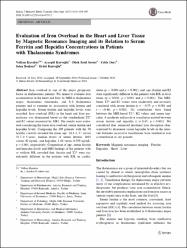Evaluation of Iron Overload in the Heart and Liver Tissue by Magnetic Resonance Imaging and its Relation to Serum Ferritin and Hepcidin Concentrations in Patients with Thalassemia Syndromes

View/
Date
2017Author
Karakuş, VolkanKurtoğlu, Ayşegül
Soysal, Dilek Ersil
Dere, Yelda
Bozkurt, Selen
Kurtoglu, Erdal
Metadata
Show full item recordAbstract
Iron overload is one of the major prognostic factor in thallassemia patients. We aimed to evaluate iron accumulation in the heart and liver by MRI in thalassemia major, thalassemia intermedia, and S- thalassemia patients and to examine its association with ferritin and hepcidin levels. Serum ferritin and hepcidin levels were recorded. Iron overload (IOL) in the heart and liver parenchyma was determined based on the standardized T2* and R2 values measured by MRI. The results were evaluated considering the tissue iron overload, serum ferritin and hepcidin levels. Comparing the 109 patients with the 30 healthy controls revealed the mean age: 24.4 +/- 11 versus 31.2 +/- 5 years, median levels of serum ferritin: 1693 versus 40 ng/mL, and hepcidin: 1.94 versus 0.355 ng/mL; p < 0.001, respectively. Comparison of age, serum ferritin and hepcidin levels and MRI findings of the patients with or without IOL revealed that, ferritin and T2* were significantly different in the patients with IOL in cardiac tissue (p = 0.004 and p < 0.001), and, age, ferritin and R2 were significantly different in the patients with IOL in liver tissue (p = 0.036, p < 0.001 and p < 0.001). The MRI-based T2* and R2 values were moderately and inversely correlated with serum ferritin (r = -0.37; p < 0.001 and r = -0.46; p < 0.001). No correlations were found between the MRI-based T2*, R2 values and serum hepcidin. A moderate and positive correlation existed between serum ferritin and hepcidin (r = 0.45; p < 0.001). We considered that, enhanced intestinal iron absorption characterized by decreased serum hepcidin levels in the intervals between successive transfusions were resulted in iron accumulation in our patients.

















